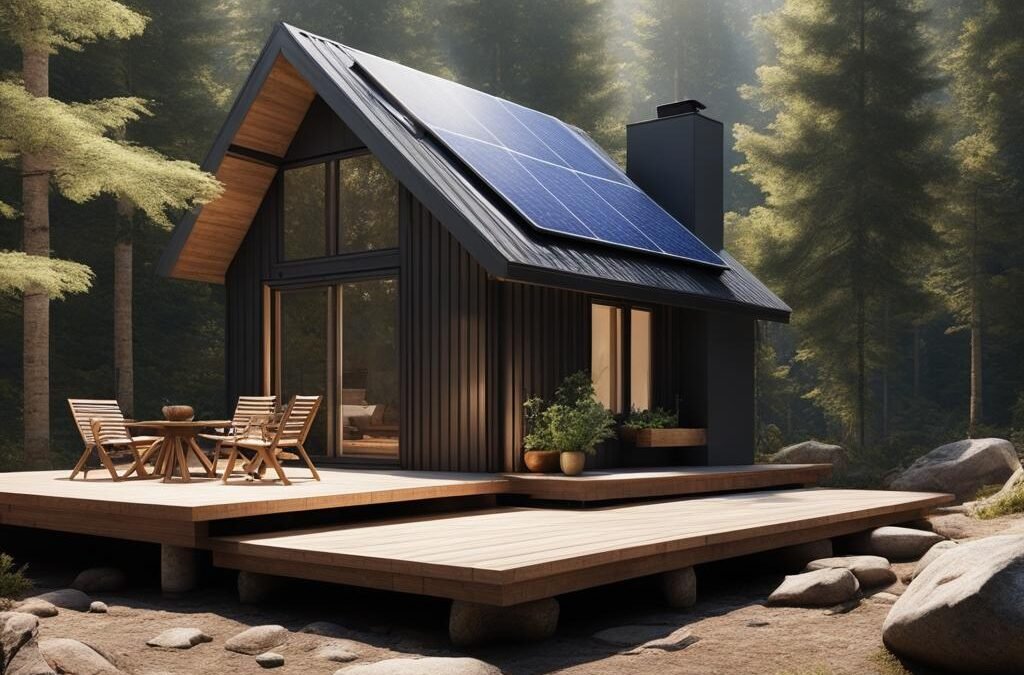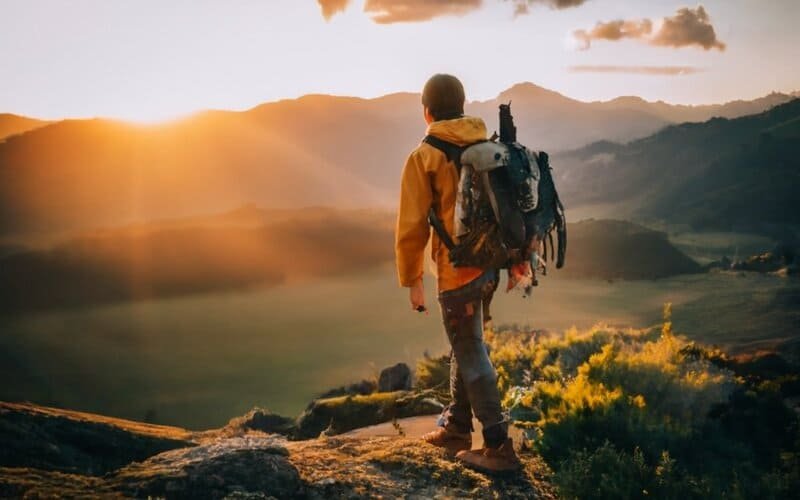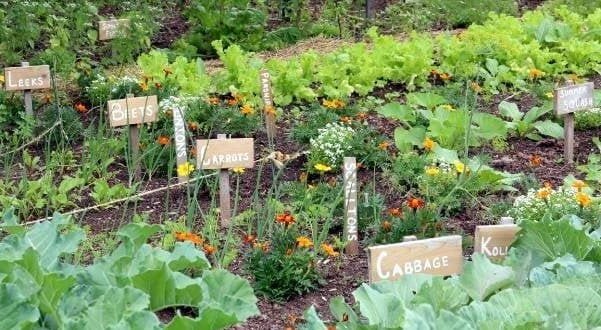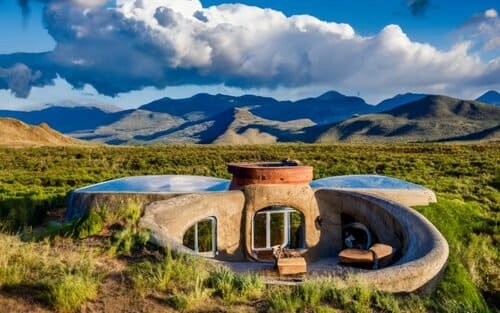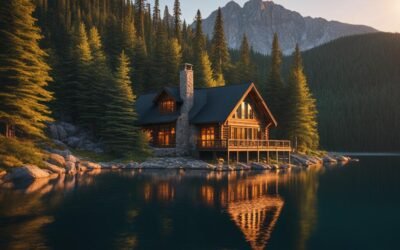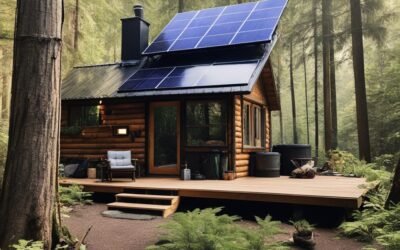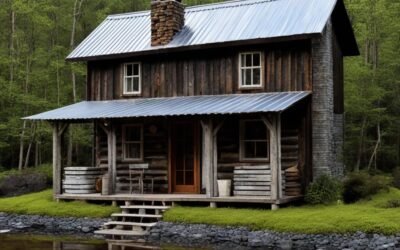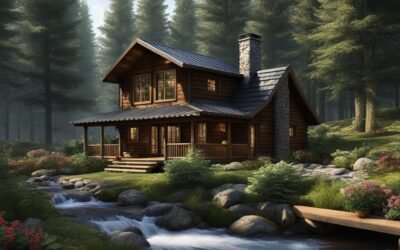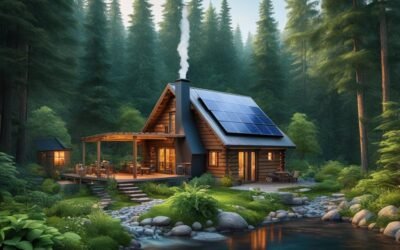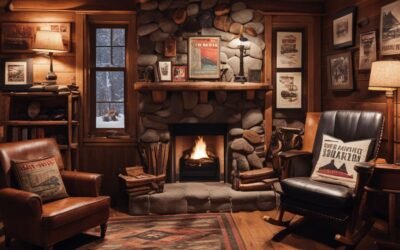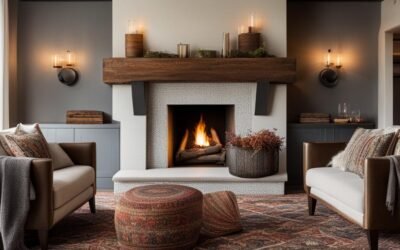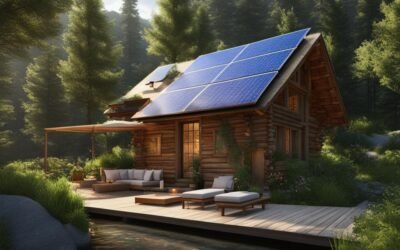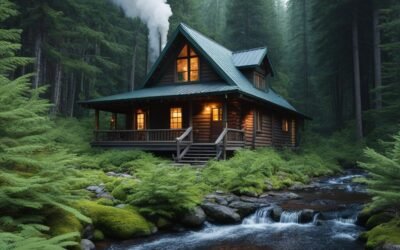Living off the grid in an off-grid cabin is a sustainable and self-sufficient way of life that allows you to embrace eco-friendly practices and reconnect with nature. Whether you’re seeking an off-grid retreat or a minimalist cabin, there are several key considerations to keep in mind to make your off-grid living experience a success.
Building an off-grid cabin requires careful planning and a focus on renewable resources. By choosing an alternative energy cabin and utilizing off-grid living techniques, you can reduce your environmental impact and live in harmony with nature. From selecting the right location to implementing energy-efficient systems, here are some tips and insights to help you create your own off-grid paradise.
Key Takeaways
- Off-grid living in an off-grid cabin promotes sustainable living and self-sufficiency.
- Choosing an alternative energy cabin and utilizing renewable resources are crucial for eco-friendly living.
- Consider the location, design, and resource needs when planning your off-grid cabin.
- Invest in an off-grid solar system to harness renewable energy.
- Ensure a reliable water source and implement effective water filtration and sanitation systems.
Planning Your Off-Grid Cabin
When it comes to building your dream off-grid cabin, careful planning is key. You want to create a self-sufficient and ecological hideaway that blends seamlessly with nature. In this section, I will guide you through the important factors to consider when planning your off-grid cabin from location selection to design and resource needs.
Choosing the Ideal Location
The first step in planning your off-grid cabin is finding the perfect location. Consider factors such as accessibility, sunlight exposure, water supply, and proximity to facilities. Aim to select a spot that offers privacy and tranquility, while also providing access to necessary resources.
Designing a Self-Sufficient Cabin
Design your cabin to maximize self-sufficiency and minimize environmental impact. Prioritize power and water accessibility, waste disposal, and insulation. Embrace alternative energy sources like solar panels, which can provide renewable electricity. Consider incorporating composting toilets and rainwater collection systems to minimize water usage and conserve resources.
Living off-grid allows you to create a true ecological oasis, where you can enjoy the tranquility of nature while minimizing your carbon footprint.
Gathering Tools and Building Supplies
Once you have your location and design plans in place, it’s time to gather the necessary tools and building supplies. Make a list of everything you’ll need, from construction materials to specialized equipment. Research local suppliers and budget for any necessary delivery costs. Having everything prepared beforehand will make the building process smoother and more efficient.
Essential Considerations for Planning Your Off-Grid Cabin
| Consideration | Description |
|---|---|
| Location | Assess accessibility, sunlight exposure, water supplies, and proximity to facilities. |
| Design | Consider power and water accessibility, waste disposal, and insulation. |
| Alternative Energy | Explore solar panels and other renewable energy sources. |
| Water Management | Utilize rainwater collection and composting toilets for sustainable water usage. |
| Gathering Supplies | List and budget for all necessary tools and building materials. |
By carefully planning your off-grid cabin, you can create a self-sufficient and ecological retreat that allows you to embrace nature while minimizing your environmental impact.
Choosing an Off-Grid Solar System
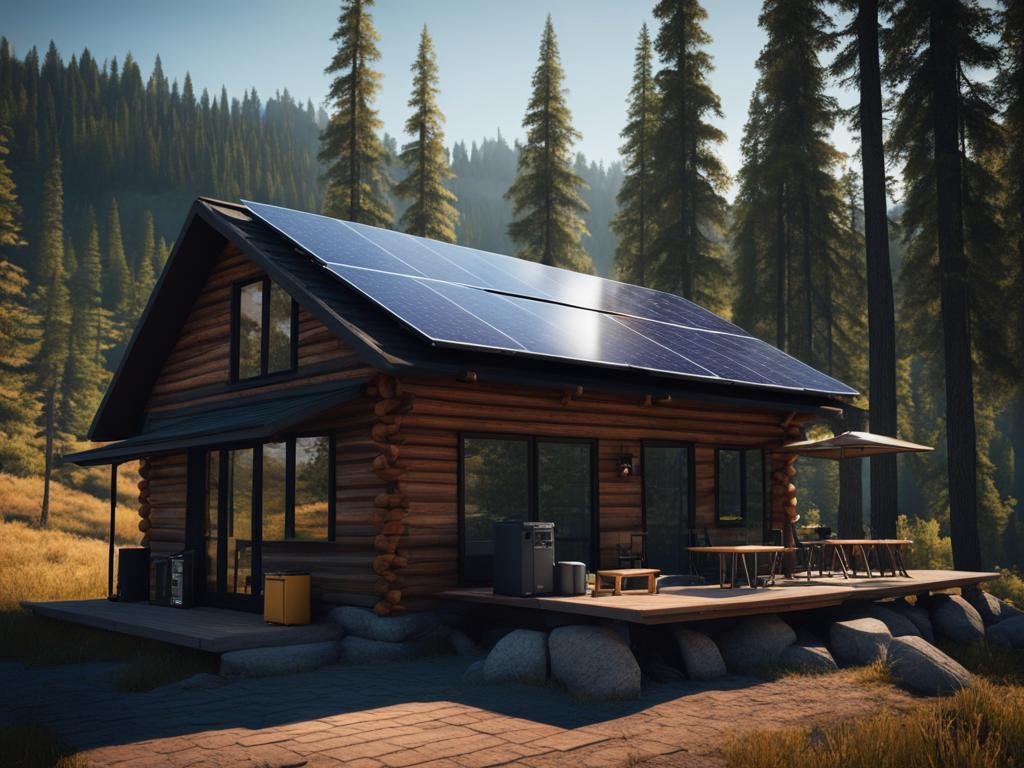 When it comes to off-grid living, harnessing renewable energy is essential. Solar power is a reliable and sustainable solution. If you’re looking for an off-grid solar system, BLUETTI offers various options to meet your needs.
When it comes to off-grid living, harnessing renewable energy is essential. Solar power is a reliable and sustainable solution. If you’re looking for an off-grid solar system, BLUETTI offers various options to meet your needs.
One popular choice is the AC200MAX, equipped with ultra-durable LFP cells and a powerful 2,200W pure sine wave inverter. This system can provide ample energy for your off-grid lifestyle. For those who require more battery capacity, the AC200MAX can be expanded by connecting BLUETTI B230 or B300 modules, allowing you to increase your storage capacity.
Another solution is the AC300 power system, which supports up to 4 B300 battery modules. This expandable system can effectively meet your energy demands. Additionally, the AC300 can be seamlessly connected to the home grid through the BLUETTI Smart Home Panel, offering flexibility and convenience for off-grid living.
For those seeking a portable option, BLUETTI offers the EP500Pro Solar Power Station. This compact system features a 5100Wh LiFePO4 battery pack and a 3000W pure sine wave AC inverter, providing reliable power wherever you go.
With BLUETTI’s off-grid solar systems, you can enjoy the benefits of renewable energy and power your off-grid lifestyle sustainably.
| Off-Grid Solar System | Key Features |
|---|---|
| AC200MAX |
|
| AC300 |
|
| EP500Pro Solar Power Station |
|
Water and Sanitation of Cabins
An off-grid cabin requires a reliable water source and sanitation system. When living in remote locations, it’s crucial to carefully consider water supply and management for everyday needs.
Water Source:
There are several options for obtaining water in off-grid cabins:
- Wells: Digging a well provides a sustainable and consistent water source. It requires professional installation and regular maintenance to ensure water quality.
- Springs: Natural springs can be tapped into for a freshwater supply. However, it’s essential to assess the flow rate and take proper measures to prevent contamination.
- Rainwater Collection: Capturing rainwater is an eco-friendly method that involves collecting rain into storage tanks. It requires an efficient gutter system and proper filtration to ensure the water is clean and safe for consumption.
Water Filtration:
To ensure the water is potable, a reliable filtration system is necessary. Filtering out impurities and contaminants improves water quality and prevents health issues. Common methods include:
- Physical Filtration: Using mesh, ceramics, or activated carbon filters to remove sediment, particles, and large impurities.
- UV Disinfection: Utilizing ultraviolet light to inactivate harmful microorganisms and bacteria.
- Chemical Disinfection: Adding disinfectants like chlorine or iodine to the water to kill or neutralize pathogens.
Composting Toilets:
Composting toilets are an eco-friendly option for off-grid cabins, minimizing water usage and eliminating the need for traditional sewage systems. These toilets facilitate the decomposition of waste material into nutrient-rich compost that can be safely used as fertilizer.
Greywater Management:
Greywater refers to wastewater generated from sinks, showers, and laundry. It can be reused for irrigation, minimizing water waste. Implementing a greywater collection and filtration system allows for responsible water management within the cabin.
Designing an efficient plumbing system is imperative to ensure continuous water supply throughout the cabin. Considerations should be given to water storage, distribution, and effective drainage.
| Water Source | Advantages | Considerations |
|---|---|---|
| Wells | Reliable and sustainable water supply | Requires professional installation and maintenance |
| Springs | Natural freshwater source | Potential contamination if not properly protected |
| Rainwater Collection | Eco-friendly option, reduces reliance on other sources | Dependent on rainfall and requires proper filtration |
In the next section, we will explore the importance of heating, cooling, and insulation in off-grid cabins, ensuring a comfortable living environment off the grid.
Heating, Cooling, and Insulation of Cabins
 When it comes to heating and cooling an off-grid cabin, there are several factors to consider. It’s important to create a comfortable living environment while minimizing energy consumption. Let’s explore some effective strategies for maintaining optimal temperatures in your cabin.
When it comes to heating and cooling an off-grid cabin, there are several factors to consider. It’s important to create a comfortable living environment while minimizing energy consumption. Let’s explore some effective strategies for maintaining optimal temperatures in your cabin.
Heating Options:
- Propane Heaters: Propane heaters are a reliable choice for heating during colder months. They provide efficient and consistent heat, making them ideal for off-grid cabins.
- Sun Heating: Harnessing the power of the sun can also contribute to heating your cabin. Southern-facing windows and well-insulated walls can help capture and retain solar heat.
- Wood Stoves: Wood stoves are a popular option, offering both warmth and ambiance. They can be fueled by sustainable and readily available firewood, making them environmentally friendly.
Insulation for Energy Efficiency:
Adequate insulation is crucial for energy efficiency and maintaining consistent temperatures in your cabin. Here are some key areas to focus on:
| Insulation Type | Benefits |
|---|---|
| Walls | Choose high R-value insulation materials to minimize heat loss or gain through the walls. |
| Roof | Consider adding a reflective roof coating to reduce heat absorption and keep the interior cool. |
| Floors | Insulate the floors to prevent heat transfer and improve energy efficiency. |
To further enhance insulation, seal any gaps or cracks that may allow drafts to enter your cabin. This will ensure that your heating efforts are not wasted and that your cabin remains comfortable.
Cooling Strategies:
In warmer months, it’s important to keep your cabin cool without relying solely on electricity. Here are some effective cooling strategies:
- Open Windows: Take advantage of cooler evening and morning temperatures by opening windows to allow natural airflow.
- Shades: Install blinds or shades to block out direct sunlight during the hottest parts of the day.
- Reflective Roofing Materials: Reflective roofing materials can help reduce heat absorption, keeping your cabin cooler.
By implementing these heating, cooling, and insulation strategies, you can create a comfortable living environment in your off-grid cabin while prioritizing energy efficiency and sustainable practices.
Construction Cost of Cabins
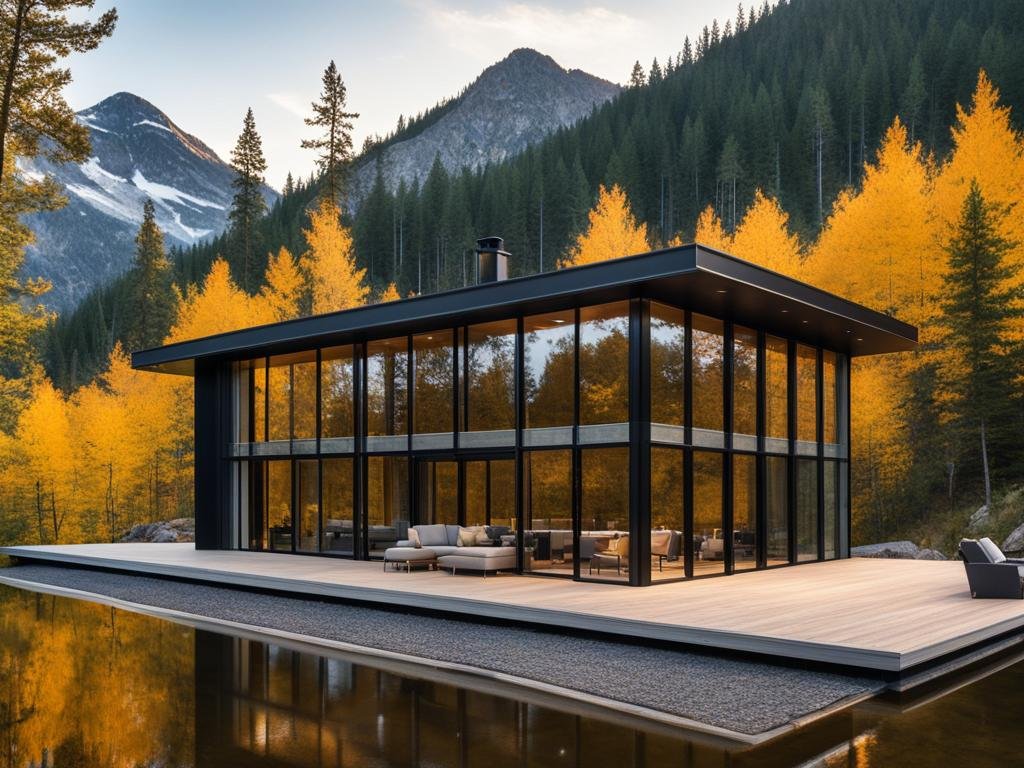 When it comes to building an off-grid cabin, the construction cost can vary depending on several factors. The size and design of the cabin, its location, and the choice of materials all play a significant role in determining the overall expenses.
When it comes to building an off-grid cabin, the construction cost can vary depending on several factors. The size and design of the cabin, its location, and the choice of materials all play a significant role in determining the overall expenses.
Compact and basic cabins are generally more affordable compared to larger and more luxurious structures. However, keep in mind that the cost of labor and material delivery can be higher in remote areas.
One important aspect to consider is the use of energy-efficient windows and insulation. While they may have higher initial costs, they can result in long-term savings by improving energy efficiency and reducing utility bills.
In addition to these factors, the cost of installing solar panels, wind turbines, or septic systems should be taken into account. These renewable energy and waste management systems are essential for a self-sufficient off-grid cabin.
It is crucial to carefully budget and plan for these expenses during the construction process. By considering long-term cost savings and making informed decisions about materials and energy systems, you can create an off-grid cabin that not only meets your needs but also aligns with your budget and sustainability goals.
| Factors | Cost Considerations |
|---|---|
| Cabin Size and Design | Compact and basic cabins are more affordable compared to larger and more luxurious structures. |
| Location | Labor and material delivery costs may be higher in remote areas. |
| Energy-Efficient Windows and Insulation | Higher initial costs can result in long-term savings by improving energy efficiency and reducing utility bills. |
| Renewable Energy and Waste Management Systems | The cost of installing solar panels, wind turbines, or septic systems should be considered for a self-sufficient off-grid cabin. |
Legal and Regulatory Considerations
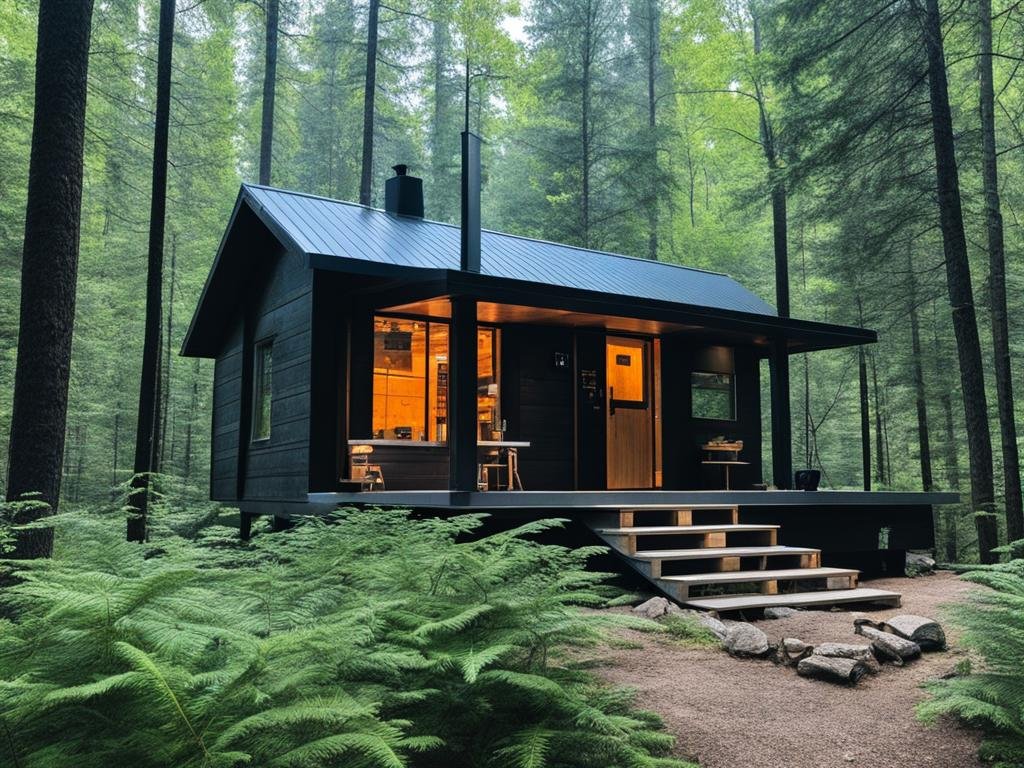 While off-grid living is a viable lifestyle option in the United States, it’s essential to navigate the legal and regulatory landscape to ensure compliance and avoid any potential issues. Here are some key considerations to keep in mind:
While off-grid living is a viable lifestyle option in the United States, it’s essential to navigate the legal and regulatory landscape to ensure compliance and avoid any potential issues. Here are some key considerations to keep in mind:
- Zoning Restrictions: Each state and local jurisdiction may have different zoning regulations that dictate where and how off-grid cabins can be built. It’s important to research and understand these restrictions before making any plans or purchasing property.
- Minimum Cabin Size: Some areas may have minimum size requirements for cabins, which could impact the design and layout of your off-grid living space. Knowing these requirements will help you make informed decisions during the planning and construction process.
- Property Rights: Understanding your property rights is crucial, as they determine your ownership and permitted use of the land. They may also affect your ability to install off-grid infrastructure like solar panels, rainwater collection systems, or composting toilets. Consult with local authorities or legal professionals to clarify your property rights.
“It’s important to stay informed about the legalities of off-grid living to ensure a smooth and hassle-free experience. By understanding and complying with zoning restrictions, minimum cabin size requirements, and property rights, you can enjoy the benefits of self-sufficiency while staying within the boundaries of the law.”
Remember, compliance with all relevant land use laws and regulations is essential when living off-grid. Doing thorough research and seeking professional advice will help you navigate the legal landscape and enjoy your off-grid lifestyle without any unnecessary complications.
References:
- Official government websites of the respective states and local jurisdictions
- Legal professionals and experts in land use and property rights
Conclusion
Living off the grid offers a unique opportunity to embrace a sustainable lifestyle, reduce our carbon footprint, and prioritize self-sufficiency. While it may require meticulous planning and upfront investment, the long-term benefits are truly rewarding.
By disconnecting from traditional utility systems, off-grid living enables us to significantly lower our monthly bills while enjoying greater independence. We become more in tune with nature, immersing ourselves in the beauty and serenity of our surroundings. This sustainable lifestyle allows us to forge a stronger connection with the environment, instilling a sense of responsibility and environmental awareness in our everyday choices.
Off-grid living encourages us to adopt wise resource management practices, ensuring the efficient use of limited resources. Embracing frugal living not only fosters self-sufficiency but also promotes a more conscious and intentional approach to our consumption habits. It inspires us to explore alternative energy sources, such as solar power, and implement sustainable solutions like composting toilets and greywater management systems.
In a world where environmental challenges are ever-present, off-grid living presents an opportunity for individuals to make a positive impact. By embracing a simpler, eco-friendly way of life, we contribute to a more sustainable future for ourselves and generations to come. As we disconnect from the grid and reconnect with nature, we create a harmonious balance between our needs and the environment, ultimately fostering a more fulfilling and meaningful existence.
FAQ
What important factors should I consider when planning an off-grid cabin?
When planning an off-grid cabin, important factors to consider include choosing the right location, designing the cabin for self-sufficiency, and considering alternative energy sources.
What should I consider when choosing the location for my off-grid cabin?
When choosing the location for your off-grid cabin, assess factors such as accessibility, sunlight, water supplies, and proximity to facilities.
How should I design my off-grid cabin to be self-sufficient?
When designing your off-grid cabin, ensure power and water accessibility, incorporate waste disposal systems like composting toilets, and use insulation for energy efficiency.
What alternative energy sources can I use for my off-grid cabin?
One popular alternative energy source for off-grid cabins is solar power, which can be harnessed using solar panels. Other options include wind turbines and hydroelectric systems.
How can I ensure a reliable water source and sanitation system for my off-grid cabin?
Options for a reliable water source and sanitation system include wells, springs, rainwater collection, and composting toilets. Water filtration and greywater management systems are also important.
What are the options for heating and cooling an off-grid cabin?
Options for heating an off-grid cabin include propane heaters, sun heating, and wood stoves. Adequate insulation is crucial for energy efficiency. Cooling can be achieved through open windows, shades, and reflective roofing materials.
How much does it cost to build an off-grid cabin?
The cost of building an off-grid cabin varies depending on factors such as size, location, and choice of materials. Compact, basic cabins are more affordable than larger, luxurious structures. Consideration of long-term cost savings is important during the construction process.
Are there any legal considerations for off-grid living?
Yes, there are legal and regulatory considerations for off-grid living, including zoning restrictions, minimum cabin size requirements, and permits for activities like rainwater collection. It’s important to research and understand the specific requirements in your area.
What are the benefits of off-grid living?
Off-grid living offers a sustainable lifestyle with reduced carbon footprint, increased self-sufficiency, and a closer connection to nature. It promotes wise resource management, frugal living, and heightened environmental awareness.

